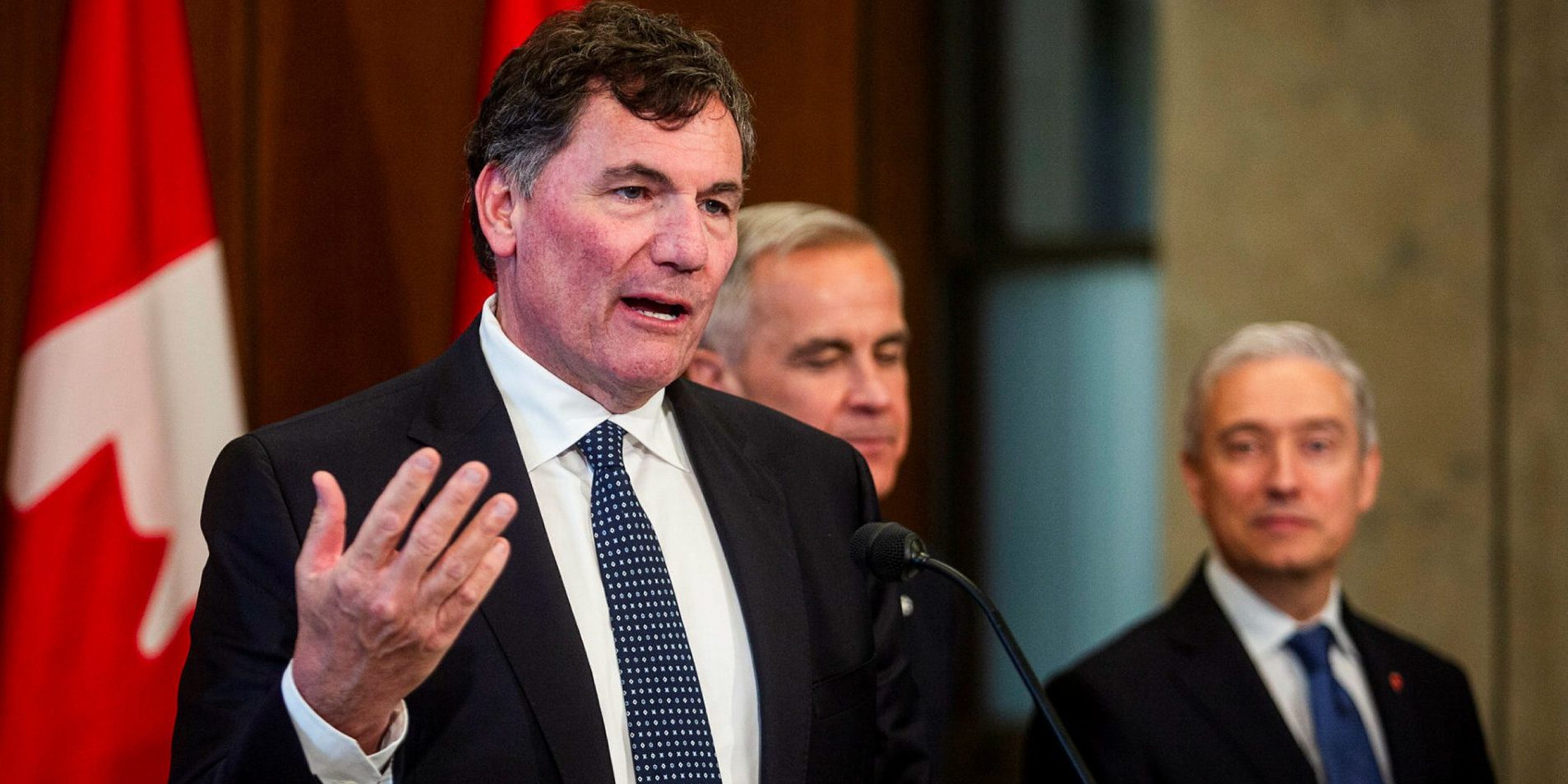Environment groups want ‘national interest’ defined in Liberals’ One Economy law

Critics of the Liberals’ recently passed One Canadian Economy Act are urging Ottawa to consult with the public to define what “national interest” means when it comes to major projects amid concerns the legislation will be used to bypass regulations intended to safeguard the environment.
“I think the first order of business is to convene a national conversation about what it means to be in the national interest. This can’t be a definition that governments and [project] proponents alone come up with. We’re still a democracy. This is an important moment in our time,” said Anna Johnston, a staff lawyer with West Coast Environmental Law.
“We could have that conversation over the summer, figure out what national interest looks like in 2025 for Canadians, and then come up with that definition and some actual criteria for how projects are qualified.”
The controversial One Canadian Economy Act, or Bill C-5, made swift progress through the House and Senate last month after being tabled on June 6 by Canada-United States Trade and Intergovernmental Affairs Minister Dominic LeBlanc (Beauséjour, N.B.). It received royal assent on June 26. The first half of the bill focuses on addressing barriers related to interprovincial trade and labour mobility through the implementation of the Free Trade and Labour Mobility in Canada Act, while the second half of the legislation enacts the Building Canada Act which intends to speed up the approval and development of “national interest projects” (NIPs) by streamlining the federal regulatory process.
Johnston told The Hill Times that the legislation offers the federal government two ways to potentially bypass environmental laws.
Under the Building Canada Act, the governor-in-council may designate a member of the King’s Privy Council for Canada as “the minister” for the purposes of the act, and that minister would have decision-making authority when it comes to NIPs. That minister would issue a single, all-in-one document that functions as the authorization under various pieces of legislation in respect to a project, rather than multiple ministers issuing individual regulatory decisions.

“What that means is that, with this wave of a pen, any prerequisites for getting those authorizations under other laws are deemed to have been met,” said Johnston.
As an example, Johnston talked about how the construction of a hypothetical mining project could be expedited under the Building Canada Act.
“Under the Fisheries Act … there’s a regulation saying that to get a section-35 authorization, the proponent has to have an offsetting plan for how it’s going to build an equal amount of habitat as the habitat that it’s destroying with the mine,” she said, but that the all-in-one document as outlined under the act “magically deems” an offsetting plan has been created, because that document is deemed to have met all requirements under the Building Canada Act.
Johnston also raised concern about section 22 of the Building Canada Act, which states that the governor-in-council may, on the recommendation of the minister responsible for the enactment, make regulations that exempt a NIP from the application of any provision of that enactment or any provision of regulations made under that enactment.
“Through section 22, the governor-in-council can make regulations saying that certain laws just don’t apply to the project at all,” she said.
When it comes to the federal government’s decisions about what environmental regulations will be followed, “the devil’s in the details,” according to Johnston.
“Because of these two—the deeming provision and then the cabinet’s authority to make regulations—it’s really going to be up to the minister to decide whether or not the conditions that he imposes in this conditions document live up to the standards of other laws, and it’s up to cabinet to decide whether to make regulations allowing projects to be exempt from laws,” she said.
“They could, theoretically, … still impose the same kind of standards and requirements on proponents as they would for any other project. The thing that worries me is that Parliament has given cabinet this power to erode those standards or bypass them. But they don’t have to.”
According to the Building Canada Act, the decision whether to designate a project as being in the “national interest” is to be based on factors such as whether the project would strengthen Canadian autonomy, resilience, and security; provide economic or other benefits to the country; have a high likelihood of successful execution; advance the interests of Indigenous Peoples; or contribute to clean growth and to meeting Canada’s objectives with respect to climate change.
Now that the bill has received royal assent, Johnston argued that a clearer definition of what constitutes the “national interest” is required.
“The factors in the bill, they keep getting talked about as if they’re criteria, but they’re not. They’re just factors that the government may or may not consider when deciding whether a project is in the national interest,” she said. “There’s at least, I should say, potential for this ability to come up with clear criteria to really clarify what we mean when we say we want to prioritize this particular project approval. The second, I think, is to convene a national conversation on which projects we actually want to go ahead.”
Through a June 27 press release, Ecojustice also called for Ottawa to work with the public, Indigenous leaders, and civil society organizations to define “national interest” for the purposes of the bill.
Since its introduction, the legislation has drawn polarizing reactions from representatives of Canada’s business and environmental groups.
Matthew Holmes, executive vice-president of the Canadian Chamber of Commerce, commended the House and Senate for the bill’s passing in a June 26 press release, and said the legislation has “the potential to overcome domestic challenges that have held the Canadian economy back for decades.”
In contrast, Environmental Defence argued in a June 24 press release that the legislation could jeopardize environmental protection and Indigenous rights, with Theresa McClenaghan, executive director and counsel of the Canadian Environmental Law Association, saying in the release that the bill fails to provide a legal framework that requires NIPs to be carried out in a manner that is “environmentally sound, democratically legitimate, and constitutionally robust.”
Thomas Green, senior climate policy adviser for the David Suzuki Foundation, argued that it is a myth that environmental regulations significantly slow down infrastructure projects. In an interview with The Hill Times, he cited a study released in 2024 by researchers from Simon Fraser University and the University of British Columbia, which looked at mines in British Columbia and found that, while regulations were cited as a factor in delays for some projects, the more common cause of delay was economic factors, particularly fluctuating commodity prices.

“That process of review has advantages, and in many cases, developers come up with projects [and] design them with the impact assessment process in mind, and come up with better projects and the kind of projects we want to see go ahead,” said Green.
“We’re fearful that we’re going to end up with projects that are poorly conceived. It might actually slow projects down, because even though they get approvals quickly, then there’s more protests and dissent about going ahead with them.”
Green told The Hill Times that now that the One Canadian Economy Act has received royal assent, the David Suzuki Foundation is advocating that the government prioritize NIPs that “make sense.”
“One is electricity—growing more renewables, energy storage, energy efficiency, and really expanding the national transmission system, because that will improve the resilience of your overall grid. It will enable more use of renewables. It helps electrify the economy, which can be Canada’s competitive advantage,” he said.
“On transportation, we can be doing a lot more to support light-duty vehicles and medium- and heavy-duty vehicles charging—so, building out charging infrastructure. We’d also like to see a lot more emphasis on national transit as a … nation-building project.”
Bill C-5 is not ‘a blank cheque for mining,’ says EY leader
To help serve as a main point of contact for project proponents, the federal government will launch a major projects office in “the coming weeks,” according to a June 26 press release from Intergovernmental Affairs.
Energy Minister Tim Hodgson (Markham-Thornhill, Ont.) said on May 23 in Calgary that the federal major projects office would reduce approval schedules for nationally significant projects from five years to two.
Theo Yameogo, EY Americas metals and mining leader, told The Hill Times that the promise of expedited project approvals provides clarity, and is not “a blank cheque for mining.”

“People are not going to be more cavalier in getting permits done because that’s not how the sector sees itself. The sector wants to be great environmental stewards, but also wants to be welcome in the communities. The government cannot provide that level of community integration or community relationship through bills. It doesn’t work like that,” said Yameogo.
“The government can put the bills forward to actually reduce the red tape and reduce the uncertainty of the timing of the permitting, but it’s up to the mining companies … to make sure they have the approval and buy-in of the communities in which they operate. And that is not a bill. That is something metals and mining companies have been doing for years and have experience doing,” he added.
On the day that Bill C-5 came into force, the federal government promised to immediately move forward on consultations with provinces, territories, Indigenous Peoples and private sector proponents to identify nation-building projects.
“The One Canadian Economy Act is a crucial step in our commitment to driving economic growth that benefits every Canadian. It will help attract investment in big nation-building projects that create good-paying jobs, connect our country, and ultimately reduce our reliance on the United States,” said LeBlanc in the Intergovernmental Affairs press release.
jcnockaert@hilltimes.com
The Hill Times






 LICENSING
LICENSING PODCAST
PODCAST ALERTS
ALERTS













